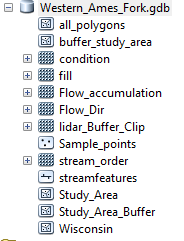Final Project: Hydrologic Effects of Improved Agricultural Practices in The Western Portion of the Ames Fork in the Pecatonica Watershed

Hydrologic Effects of Improved Agricultural Practices in The Western Portion of the Ames Fork in the Pecatonica Watershed Goals The goal of this project is to determine if a similar trend of narrowing Bankfull Width in the headwater reaches, and slight widening in the downstream reaches of watersheds has continued in Southwestern Wisconsin, Specifically in the Western Ames Fork of the Pecatonica River Watershed (Figure 1). In the mid 1930s the SCS soil conservation services implemented improved agricultural practices in an effort to protect the land and try to revert land back to presettlement times where streams were healthy in Wisconsin. I previously did similar research in the Galena River watershed (Figure 2), where data from 2017 was compared to data found in literature that compared linear regression lines from 1940 to 1979. In 2017 myself and a few other students from Missouri State performed field work in the Galena Watershed, where lead and zinc was being traced through ...





